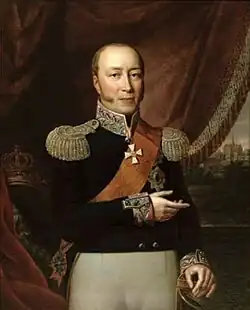Frederick Francis I
| Frederick Francis I | |
|---|---|
 Frederick Francis I, as Duke of Mecklenburg-Schwerin in swedish uniform with the Royal Order of the Seraphim. Painted by Wilhelm August Christian Abel 1803. | |
| Grand Duke of Mecklenburg-Schwerin | |
| Reign | 14 June 1815 – 1 February 1837 |
| Predecessor | Himself as Duke |
| Successor | Paul Frederick |
| Duke of Mecklenburg-Schwerin | |
| Reign | 21 April 1785 – 14 June 1815 |
| Predecessor | Frederick II |
| Successor | Himself as Grand Duke |
| Born | 10 December 1756 Schwerin, Duchy of Mecklenburg-Schwerin |
| Died | 1 February 1837 (aged 80) Ludwigslust, Grand Duchy of Mecklenburg-Schwerin |
| Burial | |
| Spouse | |
| Issue Among others | Frederick Louis, Hereditary Grand Duke of Mecklenburg-Schwerin Louise Charlotte, Hereditary Princess of Saxe-Gotha-Altenburg Duke Gustav Wilhelm Charlotte Frederica, Hereditary Princess of Denmark |
| House | Mecklenburg-Schwerin |
| Father | Duke Louis of Mecklenburg-Schwerin |
| Mother | Princess Charlotte Sophie of Saxe-Coburg-Saalfeld |
| Religion | Lutheranism |
Frederick Francis I (10 December 1756 – 1 February 1837) ruled over the German state of Mecklenburg-Schwerin, first as Duke from 1785 to 1815, and then as Grand Duke from 1815 until his death in 1837.
Early life

Frederick Francis I was born in Schwerin, Duchy of Mecklenburg-Schwerin, on 10 December 1756. He was the son of Duke Louis of Mecklenburg-Schwerin and Princess Charlotte Sophie of Saxe-Coburg-Saalfeld.
His paternal grandparents were Christian Ludwig II, Duke of Mecklenburg-Schwerin (son of Frederick, Duke of Mecklenburg-Grabow) and Duchess Gustave Caroline of Mecklenburg-Strelitz (daughter of Adolphus Frederick II, Duke of Mecklenburg-Strelitz). His maternal grandparents were Franz Josias, Duke of Saxe-Coburg-Saalfeld and Princess Anna Sophie of Schwarzburg-Rudolstadt.
Career
In 1785, Friedrich Franz succeeded his uncle Frederick II as Duke of Mecklenburg-Schwerin.
Following the Napoleonic Wars, Friedrich Franz was raised to the dignity of Grand Duke at the Congress of Vienna.[1] Along with his cousin in Mecklenburg-Strelitz, he was known as one of the most reactionary German rulers.
Personal life
On 1 June 1775 in Gotha, Friedrich Franz married Princess Louise of Saxe-Gotha-Altenburg, the fourth and youngest child of Prince John August of Saxe-Gotha-Altenburg and Countess Louise Reuss of Schleiz. Together, they had eight children,[a] including:
- Frederick Louis, Hereditary Grand Duke of Mecklenburg-Schwerin (1778–1819), who married Grand Duchess Elena Pavlovna of Russia, a daughter of Paul I of Russia and Duchess Sophie Marie Dorothea of Württemberg.
- Duchess Louise Charlotte of Mecklenburg-Schwerin (1779–1801), who married Emil Leopold August, Duke of Saxe-Gotha-Altenburg, the second son of Ernst II, Duke of Saxe-Gotha-Altenburg and Princess Charlotte of Saxe-Meiningen.[3]
- Duke Gustav Wilhelm of Mecklenburg-Schwerin (1781–1851), who never married.[b]
- Duke Karl of Mecklenburg-Schwerin (1782–1833).
- Duchess Charlotte Frederica of Mecklenburg-Schwerin (1784–1840), who married Christian VIII of Denmark. They were parents to Frederick VII of Denmark.
- Duke Adolf of Mecklenburg-Schwerin (1785–1821).
On his death in 1837 he was succeeded by his grandson, Grand Duke Paul Friedrich.
Notes
- ^ His eldest daughter, stillborn on 7 May 1776, was buried in the Schelfkirche St. Nikolai of Schwerin.[2] His eldest son, stillborn on 11 May 1777, was also buried in the Schelfkirche St. Nikolai of Schwerin.[2]
- ^ Karl Heinrich Ulrichs mentions Duke Gustav Wilhelm as a homosexual.[4]
References
- ^ Haydn, Joseph (1855). History of the Wars of the French Revolution. Bangs. p. 555.
- ^ a b Schelfkirche St. Nikolai zu Schwerin in: worldhistory.de [retrieved 2 March 2017].
- ^ Haggerty, George; Zimmerman, Bonnie, eds. (2000). "German Literature". Encyclopedia of Lesbian and Gay Histories and Cultures. p. 612. ISBN 0-815-34055-9.
- ^ Karl Heinrich Ulrichs: Argonauticus. Serb, Leipzig 1869, p. 100